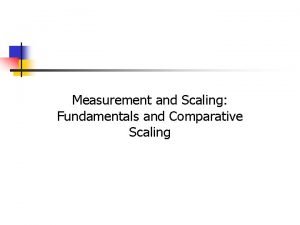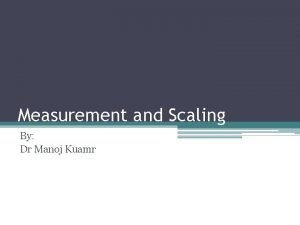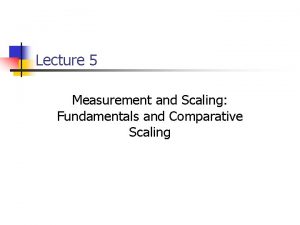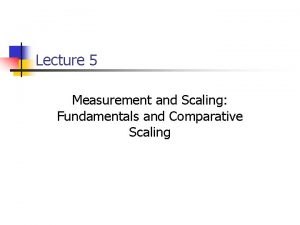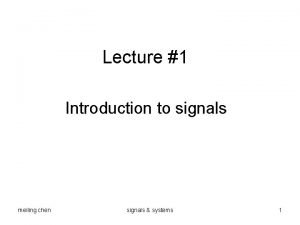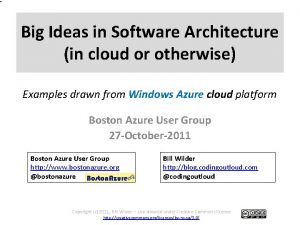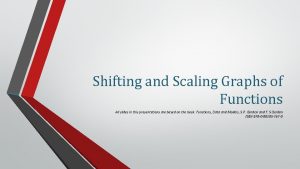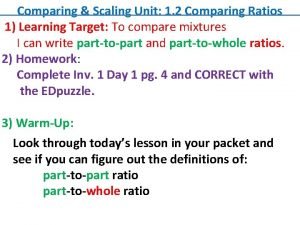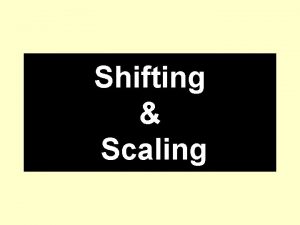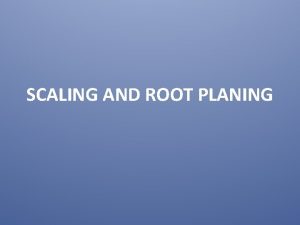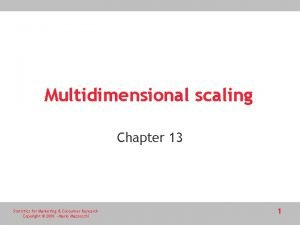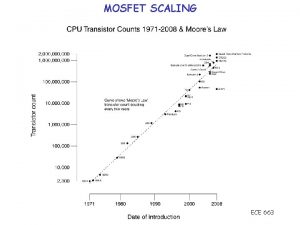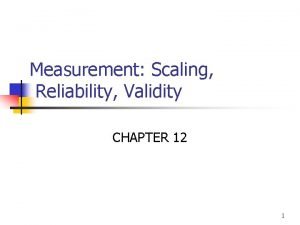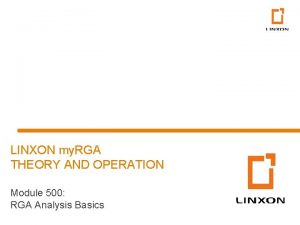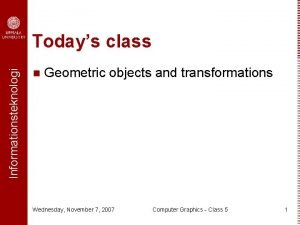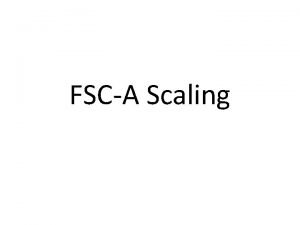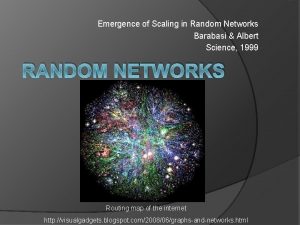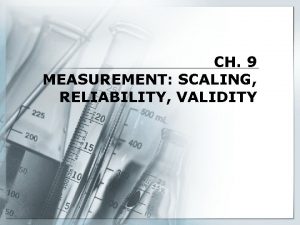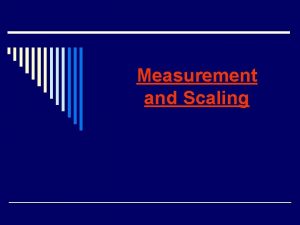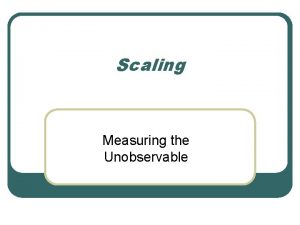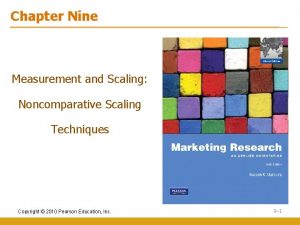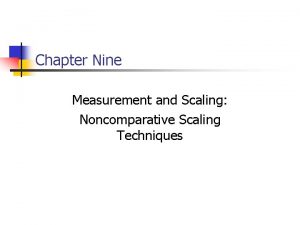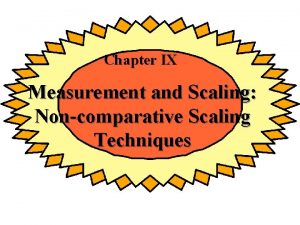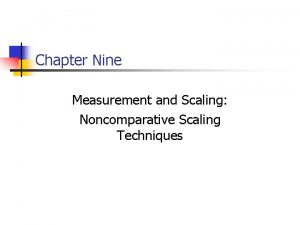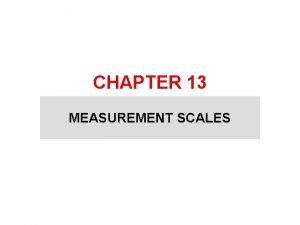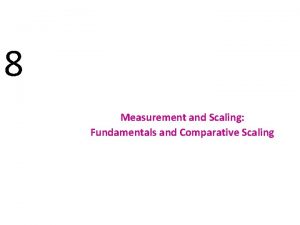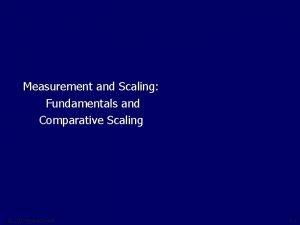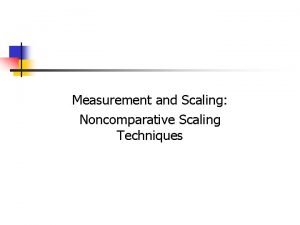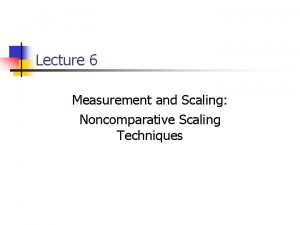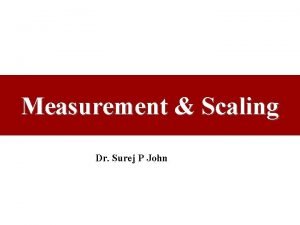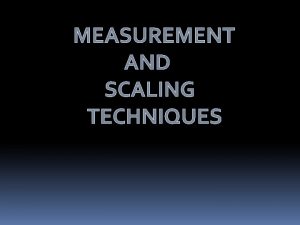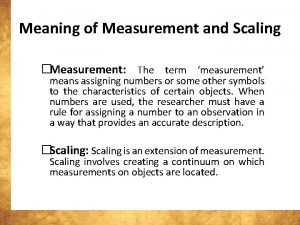Chapter 7 Measurement and Scaling Mc GrawHillIrwin Copyright






























- Slides: 30

Chapter 7 Measurement and Scaling Mc. Graw-Hill/Irwin Copyright © 2013 by The Mc. Graw-Hill Companies, Inc. All rights reserved.

Learning Objectives • Understand the role of measurement in marketing research • Explain the four basic levels of scales • Describe scale development and its importance in gathering primary data • Discuss comparative and noncomparative scales 7 -2

Value of Measurement in Information Research • Precise physical measurement is critical – Essential to effective decision making 7 -3

Overview of the Measurement Process • Measurement: An integrative process of determining the intensity (or amount) of information about constructs, concepts, or objects – Consists of two tasks: • Construct selection/development • Scale measurement 7 -4

What Is a Construct? • An abstract idea or concept formed in a person’s mind – A combination of a number of similar characteristics of the construct 7 -5

Construct Development • Construct: A hypothetical variable made up of a set of component responses or behaviors that are thought to be related – Construct development: An integrative process in which researchers determine what specific data should be collected for solving the defined research problem 7 -6

Exhibit 7. 1 - Examples of Concrete Features and Abstract Constructs of Objects 7 -7

Exhibit 7. 1 - Examples of Concrete Features and Abstract Constructs of Objects 7 -8

Scale Measurement • The process of assigning descriptors to represent the range of possible responses to a question about a particular object or construct – Scale points: Designated degrees of intensity assigned to the responses in a given questioning or observation method 7 -9

Four Basic Scale Levels Nominal Scale • The type of scale in which the questions require respondents to provide only some type of descriptor as the raw response Ordinal Scale • A scale that allows a respondent to express relative magnitude between the answers to a question Interval Scale • A scale that demonstrates absolute differences between each scale point Ratio Scale • A scale that allows the researcher not only to identify the absolute differences between each scale point but also to make comparisons between the responses 7 -10

Exhibit 7. 2 - Examples of Nominal Scales 7 -11

Exhibit 7. 3 - Examples of Ordinal Scales 7 -12

Exhibit 7. 4 - Examples of Interval Scales 7 -13

Exhibit 7. 5 - Examples of Ratio Scales 7 -14

Evaluating Measurement Scales • Scale reliability - Refers to the extent to which a scale can reproduce the same or similar measurement results in repeated trials – Techniques that help scale reliability: • Test-retest • Equivalent form 7 -15

Evaluating Measurement Scales • Scale validity - Assesses whether a scale measures what it is supposed to measure – Face validity – Content validity – Convergent validity – Discriminant validity 7 -16

Criteria for Scale Development • Understanding of the questions • Discriminatory power of scale descriptors – Discriminatory power: The scale's ability to discriminate between the categorical scale responses (points) • • Balanced versus unbalanced scales Forced or nonforced choice scales Negatively worded statements Desired measure of central tendency and dispersion 7 -17

Exhibit 7. 7 - Relationships between Scale Levels and Measures of Central Tendency and Dispersion 7 -18

Scales to Measure Attitudes and Behaviors • Likert scale: An ordinal scale format that asks respondents to indicate the extent to which they agree or disagree with a series of mental belief or behavioral belief statements about a given object 7 -19

Scales to Measure Attitudes and Behaviors • Semantic differential scale: A unique bipolar ordinal scale format that captures a person's attitudes or feelings about a given object – Credibility construct consisting of three dimensions is used: • Expertise • Trustworthiness • Attractiveness 7 -20

Scales to Measure Attitudes and Behaviors • Behavioral intention scale: A special type of rating scale designed to capture the likelihood that people will demonstrate some type of predictable behavior intent toward purchasing an object or service in a future time frame 7 -21

Exhibit 7. 8 - Construct/Scale Development Process 7 -22

Other Rating Scales • Noncomparative rating scales: A scale format that requires a judgment without reference to another object, person, or concept • Comparative rating scales: A scale format that requires a judgment comparing one object, person, or concept against another on the scale 7 -23

Other Rating Scales • Graphic rating scales: A scale measure that uses a scale point format that presents the respondent with some type of graphic continuum as the set of possible raw responses to a given question • Rank-order scales: These allow respondents to compare their own responses by indicating their first, second, third, and fourth preferences, and so forth 7 -24

Other Rating Scales • Constant-sum scales: Require the respondent to allocate a given number of points, usually 100, among each separate attribute or feature relative to all the other listed ones 7 -25

Other Scale Measurement Issues • Single-item scale: A scale format that collects data about only one attribute of an object or construct • Multiple-item scale: A scale format that simultaneously collects data on several attributes of an object or construct – Clear wording 7 -26

Marketing Research in Action: What Can You Learn from a Customer Loyalty Index? • What level of scale design would be most appropriate in creating necessary scale measurements for collecting primary data on each construct? • For each construct, design an example of the actual scale measurement that could be used to collect the data. 7 -27

Marketing Research in Action: What Can You Learn from a Customer Loyalty Index? • What weaknesses exist in how Burke assesses its Secure Customer Index? – Make sure to clearly identify each weakness and explain why it is a weakness. • What types of scale measurement would you have used to collect the needed data for calculating SCI®? – Why? Write some scale measurements you would use. 7 -28

Marketing Research in Action: What Can You Learn from a Customer Loyalty Index? • What level of scale design would be the most appropriate in creating the necessary scale measurements for collecting primary data on each construct? • For each construct, design an example of the actual scale measurement that could be used by Burke, Inc. , to collect the data. 7 -29

Marketing Research in Action: What Can You Learn from a Customer Loyalty Index? • If you were the lead researcher, what types of scale measurement would you have used to collect the needed data for calculating SCI®? – Why? – Write some scale measurements you would use. 7 -30
 What is comparative scale
What is comparative scale Manoj kuamr
Manoj kuamr Scales of measurement
Scales of measurement What is comparative scale
What is comparative scale Examples of ordinal scale
Examples of ordinal scale Chen
Chen Scaling up and down
Scaling up and down Shifting and scaling graphs
Shifting and scaling graphs Comparing and scaling unit test
Comparing and scaling unit test Shifting and scaling functions
Shifting and scaling functions Classification of periodontal instruments
Classification of periodontal instruments Bridge scaling
Bridge scaling Misha bilenko
Misha bilenko Scaling factors in vlsi
Scaling factors in vlsi Rajesh nishtala
Rajesh nishtala Kv-40rw
Kv-40rw Anderson
Anderson Scaling by powers of ten
Scaling by powers of ten Scaling by powers of ten
Scaling by powers of ten Dynamic resolution scaling
Dynamic resolution scaling Receive side scaling
Receive side scaling Multidimensional scaling in marketing
Multidimensional scaling in marketing Velocity saturation
Velocity saturation Scaling example
Scaling example Rga scaling
Rga scaling Dennard scaling
Dennard scaling Uniform scaling in computer graphics
Uniform scaling in computer graphics Uniform scaling in computer graphics
Uniform scaling in computer graphics Fsc-h
Fsc-h Emergence of scaling in random networks
Emergence of scaling in random networks Scaling transparency hides
Scaling transparency hides
